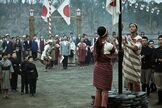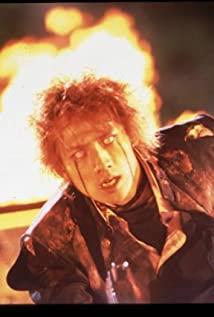Comparative analysis // Some modifications have been made to the paper
——Comparative analysis of the films "Revelation" and "Sedek Bale"
Abstract: Conflicts of tribal civilizations can actually be divided into two categories. One is the conflict between tribes and tribes in the age of cold weapons. The two opposing sides of this conflict may be evenly matched, or it may be because of political forms and other factors. There is a huge disparity, such as the two sides in the city and the virgin forest in "Revelation", and the two sides of equal strength such as Wushe Mahpo and Daozhe in "Sedek Bale"; the other type is It is the attack and breaking of cold weapons by hot weapons, which is reflected in the end of "Revelation", which represents the arrival of the age of navigation of industrial civilization and the "civilization" of the primitive tribes of Wushe after the Japanese occupied Taiwan in "Sedek Bale". and enslavement. These two categories are reflected in both films, with strong similarities and great differences, but without exception, the conflict between conquest and resistance is presented in an extremely violent angle. The following content will also discuss in more detail how the two Chinese and foreign directors Wei Desheng and Mel Gibson deal with the proportion of violent narrative perspectives in films related to the themes of "guarding one's own civilization" and "civilization evolution". and presentation.
Key words: violent narrative; civilization; comparison between China and foreign countries; primitive tribe;
1. Overview of the "narrative of violence"
Throughout the articles related to film literature and art, the narrative angle actually only lies in distinguishing whether the film's cut-in perspective or viewpoint is omniscient, limited, objective, or third-person, etc., which belongs to a very basic unit. In fact, "narrative of violence" is actually more widely used in Chinese modern and contemporary literature, an enlightenment perspective on politics or ideas. The reason why this concept is introduced in film analysis is that in the two films mentioned in this article, As a way of expressing conflict, violence can be very intuitive to tell the story and is so natural without bringing too much sensory stimulation and aesthetic fatigue.
Whether it is the conquest of a civilization by a civilization, or the alienation or assimilation of a civilization under the guidance of another civilization, the conflict and evolution of civilizations are indispensable to the force of violence, which also makes the violent narrative angle a relevant movie. The basic unit in . Different from the depiction of violent aesthetics in films such as Quentin, it tries to use an aesthetic artistic expression to dissolve the original brutal tension of violence, and instead uses visual means to attract the attention of the audience. Aside from the question of whether violence naturally produces excitement, curiosity or fear and shock, in my opinion, violence as the basic unit and basic element of movies is still biased towards barbarism and purity. original nature.
The most brilliant line in "Sedek Bale": If your civilization is to make us bow down, then I will show you the pride of the barbaric. Here, I almost equate brutality and violence, and one-sidedly take violence as the most basic way to respond to the world to analyze and compare the two films.
2. Control the rhythm of violent narratives
In the two films, violence not only assumes the role of conflict, but also serves as an expression of ritual. These two methods show both certain advantages and certain defects in the process of representing the conflict and evolution of civilizations. In "Revelation", the most prominent manifestation of violence is in the expression of rituals, which originated from the cruelty and bloody sacrifices of Aztec civilization (or Mayan civilization, there is a dispute here), and even partially eliminated the fight between humans and beasts The violent feelings of the people poured all the elements of violence into the reproduction and existence of people. Corpse water and fresh blood flow, pierced swords, rolling heads, and beating hearts are the violent means of people fearing the gods; the running of tiger claws to eliminate fear in the heart is also a violent confrontation; Ah'Dai lost his fertility , Tiger Claw's wife's underwater production, all brought a violent emotional color in my heart, but the first one is more concrete and prominent. This kind of narrative rhythm cleverly traps people in the traps set in advance. When people are tense between the two tribes, and in the end, it is just the general's struggle for his son's revenge and the tiger claw's personal struggle. When the sailing ships of the civilized maritime industry era came quietly, people suddenly realized that they re-examined the position of people in the chain of civilization. But in my opinion, the disadvantage of such a state is that in the first half of the paragraph, the balance of civilization is too much in the cold weapon tribe, and it tends to be among the equal and happy tribes where the tiger claw is located, and violence is given a slightly derogatory definition in advance. , to examine the cold weapon civilization at that time with a more modern view of civilization history. It is also because of this that Tiger Claw finally chose to return to the forest, from the continuously expanding spatial structure to finally shrinking to that forest. Before Tiger Claw lost his incomprehension and curiosity about the rest of the tribe, he did not resist for the time being in the end. The contradiction of not exploring, to a certain extent, makes me unable to understand the director's intention very well, of course, it may also be intentional.
In Seediq Bale, violence is set up as a conflict between each side and the other. At first, they scrambled for prey with the Daoze people, and after exchanging food with the Han people, they also had to ambush on the road. After the Japanese came, they attacked with sharp arrows and boulders. The entire confrontation to the Wushe incident did not conceal a violent color, and the rhythm was controlled so naturally and skillfully that the audience's feeling for this violence was no longer rejection and resistance, but an understanding. with acceptance. And because "Sedek Bale" highlights the battle and fighting process between hot weapons and cold weapons, the confrontation between spears and swords and guns and grenades, on the contrary, the spears and swords have more primitive violent colors, and the guns and grenades attack quickly. It lacks the audience's experience of violence. But again, as most viewers said, the violence in "Sediq" is reflected in the confrontation and battle again and again, which makes the battle scene in the lower "Rainbow Bridge" slightly complicated. But it is also these repeated struggles that make it more in line with a simple value than the view of civilized history in Revelation. At a time when he knew that the Japanese were stronger, he still had the mentality of hitting a stone with an egg and shaking a tree with an oyster. To convey a civilization of communication and blending. When the Wushe tribe attacked during the games, they did not give up killing Japanese women and children like the usual halo of justice for the weak. Such a behavior that seems to directly violate the common sense of people's own cognition makes me feel that director Wei Desheng is in "Sediq" " does not give any subjective characterization of "violence", it is just a presentation of its original appearance. Based on this, his rhythm control has become both a burden and a feature.
The control of the violent narrative rhythm in the two films also reflects the director's cognition of violence. From my understanding, Mel Gibson focuses more on the violence of an individual or a group itself. Sacrificial ceremonies, production and reproduction, the body of the saint who was whipped in "The Passion of the Christ", the element of violence is more natural; Wei Desheng's expression of violence used in each battle between the two sides in "Sedek Bale" makes violence possible. A more formalized, more externalized or more acquired sense of rhythm.
This point is also closely linked to the expression of the theme. The violence of tiger paws, the violence of sacrifice, and the violent confrontation with another civilization all prompted him to eliminate his fear and return to his wife and children. Violence is a means of expression, and in his heart There is no consideration for civilization itself; on the other hand, Mo Na, knowing that the Japanese army is denser than the leaves of the forest and more stones than the Zhuoshui Stream, has a firmer determination than Mount Qilai. He knew that Japan brought schools, post offices, and hospitals that seemed to be more representative of civilization, but he still used violence to resist, because he said that Seediq must win the soul, which is a more purposeful expression of violence. On this basis, the balance of love in my heart is slightly biased towards Mona's personal charm and the movie "Sedek Bale".
3. Artistic Presentation of Violent Narratives
Although both films try to restore the most primitive features of violence, they still do not affect the artistic expression of some segments. They are both artistic expressions of individuality, and there is no difference between them.
Recalling the most artistically expressed violent narrative segment in "Seediq", I recalled that I was reviewing some relevant comments while watching the movie. One of the comments said: The beheading at the 108th minute shocked me. Looking at the progress bar, at 107 minutes, I had anticipation for the upcoming plot: a torch was thrown into the air, the Japanese officer looked up, and the head was already in his hand. Repeated backwards, aftertaste.
In "Seediq" and "Revelation", there is a non-traditional bloody and extremely aggressive conflict, which can also be called a violent scene in my subjective opinion; in "Seediq", the Mahpo people often sing Singing, dancing under trees and on cliffs, the impact of pictures and music is not weaker than traditional violence, but stronger; Taken to the surface, these two individuals, as vulnerable dust particles in the chain of civilization, express their violence in their own way, so that when the two films tell about the change of civilization, their violent narrative has an expression that transcends civilization itself.
4. Conclusion
For civilization itself, although the two directors accept different cultural infiltrations, they show strong similarities. From the perspective of the history of modern civilization, the intervention of high-level civilization has a certain anti-violence color. For example, although the Japanese have not achieved fairness and equality, although the ultimate goal is assimilation, they are still used in schools and other modern places. Small-scale. Benefit the Seediq; according to historical records, it may be that Spanish sailing ships came to the American continent, led by missionaries with top hats.
The two films with violence as the basic element are more brilliant and heavy than the films that promote the aesthetics of violence. They don't make violence a central talking point, and they don't make a lot of noise to lead people to enjoy or resist violence. However, it inadvertently conveys a novel entry point, with a violent narrative as a breakthrough, then this violence can break free from the shackles of the inherent tradition and present a more natural, primitive and even lovely. So when the next unknown civilization arrives, what kind of violence will we use to confront it? Will we go to violent confrontation?
How it feels to write essays and screenplays
View more about Sai de ke · ba lai: Tai yang qi reviews











